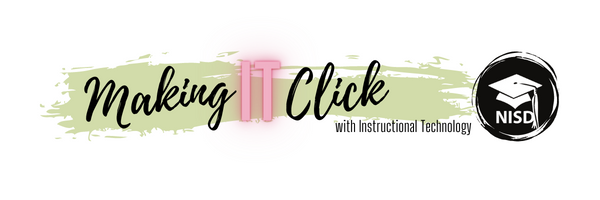Library Media Specialist, Kelley Valdez, at Roanoke Elementary recently led her campus through a month-long exploration of Computer Science. When planning for kindergarten Hour of Code, Mrs. Valdez said she wanted to make sure that the exploration not only hit on aspects of computer science education but also incorporated kindergarten specific TEKS. The lesson had a hands-on Robotics component where students had to collaborate, problem-solve, and communicate with a team to move their robot mouse through an alphabet "maze" and then she provided an opportunity for "solo" time to put their hands-on learning to practice via the app Beebot and for some classes, the app The Foos.
Mrs. Valdez approached her library lesson with a few goals in mind for her youngest learners. She explained that she wanted students to understand that computers and robots do not work on their own. During the lesson, she shared with her learners that robots and computers need human interaction (programming) to give them the needed steps to perform the task. She also wanted students to have the opportunity to work with a team as well as working on their own.
Katelyn Cole is a Kindergarten teacher whose students experienced the coding lesson taught by Mrs. Valdez. Mrs. Cole explained that during the library lesson Mrs. Valdez talked about how computers don't speak English like us, they speak in a different way called code. Mrs. Cole explained that the kids were taught to program what they wanted the mouse to do with arrows and entry buttons. Mrs. Cole also shared that Mrs. Valdez taught her students that computers will remember all steps you tell it until you "clear their minds". The Foos and BeeBot were apps that carried over into the classroom and both incorporate programming and coding in order to make a character move to reach their destination.
Through the two activities, students were able to work on letter identification, observing and describing the location of an object and ways that object can move, as well as use terms to describe the location. Luckily for these kindergarteners, the learning did not stop in the library.
Mrs. Cole continued what her students had learned in the library into her own classroom Her Students were challenged to think more critically and collaborate with each other in order to reach a goal. Mrs. Cole believes that “not only is this a growing job for our future kids, but it is also an opportunity to use our Ranger Learner Actions- Listen, Think, Wonder, Connect, Persevere, Collaborate, and Reflect. These are skills that are crucial to the development of young learners! At Roanoke Elementary we believe in instilling all of these learner actions early, to help develop well-rounded and problem- solving students.”
While working with the hands-on robot, Mrs. Valdez set her kids up for success by skillfully designing her lesson with great management and instructional strategies One key point that made the experience powerful was her use of color-coded jobs to allow everyone to participate in the activity. One student (color) might be the programmer, while others are in charge of positioning objects in the maze and providing feedback to the programmer as they work to figure out the program to get their robot to complete the assigned task. When Mrs. Valdez reflected on her coding lessons she shared, “It is always heart-warming to see how students really pull together during the Hour of Code to help each other out of the "pit" or a struggle."
For the learners at Roanoke Elementary their experiences with coding do not stop in Kindergarten Mrs. Valdez explains that she makes plans to build upon each grade level experiences during the Hour of Code to increases the rigor from year to year. All grade levels have a hands-on robotics component and a solo app/program based component. Each year students graduate to a more complex robot or a more rigorous task that increases the level of coding required to complete the task.
Mrs. Cole’s class practices coding during small group days in math and in the mornings before school starts. Mrs. Cole’s students look forward to their time working on The Foos and BeeBot. This has been a positive reinforcement tool she has used to help students stay focused on other jobs and complete work. It's also been a great tool to practice teamwork and collaboration. Mrs. Cole believes coding has been wonderful for emphasizing that talking about ideas solves the problem faster than arguing or trying to solve the problem alone. Mrs. Cole will be submitting this experience to Expo 2018, she said: “she hopes that she can share with a larger audience what our experiences have been as young programmers.”
According to Mrs. Valdez, the Kindergarten students at Roanoke Elementary were actively engaged in problem-solving throughout the hour and put their Ranger Learner Actions into practice. They were able to make the connection between their thinking and action to the way that their robot or app bot moved. Mrs. Valdez did a phenomenal job in December designing her lessons to use technology as a tool to enhance the learning experience for her students while building a bridge to what can happen in kindergarten classroom when we believe in the power of coding.

No comments:
Post a Comment
Note: Only a member of this blog may post a comment.